Neighborhoods of Portland, Oregon facts for kids
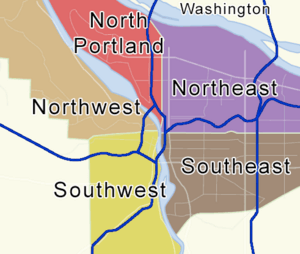
Welcome to Portland, Oregon! This amazing city is split into six main parts: North Portland, Northeast Portland, Northwest Portland, South Portland, Southeast Portland, and Southwest Portland.
Inside these big sections, Portland has 95 official neighborhoods. Each neighborhood has its own group of volunteers called a neighborhood association. These groups help connect the people living in the neighborhood with the city government. They make sure everyone's voices are heard! Sometimes, a neighborhood might even stretch across two of the big city sections.
Exploring Portland's Neighborhoods
Each neighborhood in Portland has its own special borders. These borders are decided by the neighborhood associations themselves. Sometimes, a neighborhood might even include areas just outside Portland's city limits! Also, some neighborhoods can cross the lines between the six main city sections.
The list below shows many of Portland's neighborhoods. You'll see which main section they are in, which group (coalition) they belong to, and sometimes how they got their name!
| Neighborhood name | Sextant (City Section) | Coalition (Neighborhood Group) | Namesake (How it got its name) | Image | Notes |
|---|---|---|---|---|---|
| Alameda | Northeast | Northeast Coalition of Neighborhoods | Named by the Alameda Land Company, which first planned the area. | 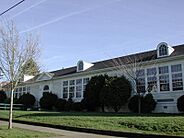 |
|
| Arbor Lodge | North | North Portland Neighborhood Services | 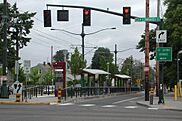 |
||
| Ardenwald-Johnson Creek | Southeast | Southeast Uplift Neighborhood Coalition | Named after Arden M. Rockwood, whose father first planned this area. | 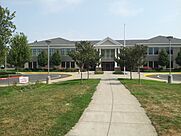 |
Partially in Portland and Milwaukie. Both cities recognize this neighborhood. |
| Argay | Northeast | East Portland Community Office | A mix of names from Art Simonson and Gerhardt "Gay" Stavney, who planned the neighborhood. | ||
| Arlington Heights | Northwest | Neighbors West-Northwest | 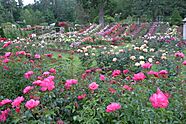 |
||
| Arnold Creek | Southwest | Southwest Neighborhoods | Named after Arnold Creek. | 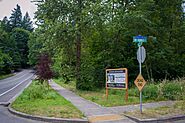 |
|
| Ashcreek | Southwest | Southwest Neighborhoods | |||
| Beaumont-Wilshire | Northeast | Northeast Coalition of Neighborhoods | Beaumont means "beautiful mountain" in French. Wilshire's name origin is not known. | 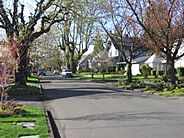 |
|
| Boise | North, Northeast | Northeast Coalition of Neighborhoods | Named after Reuben P. Boise, an Oregon Supreme Court Justice. | 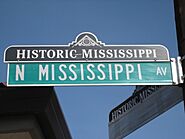 |
Includes the Mississippi District. |
| Brentwood-Darlington | Southeast | Southeast Uplift Neighborhood Coalition | 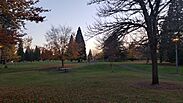 |
||
| Bridgeton | North, Northeast | North Portland Neighborhood Services | Named after the Bridgeton Slough, which was named for the Interstate Bridge. | ||
| Bridlemile | Southwest | Southwest Neighborhoods | |||
| Brooklyn | Southeast | Southeast Uplift Neighborhood Coalition | Named for the many rivers, creeks, and lakes that used to be in the area. | 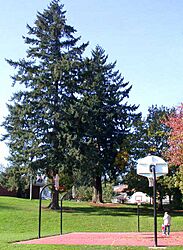 |
|
| Buckman | Southeast | Southeast Uplift Neighborhood Coalition | Named after City Councilor Cyrus Buckman. | 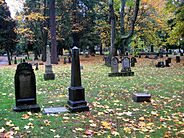 |
|
| Cathedral Park | North | North Portland Neighborhood Services | Named after Cathedral Park. | 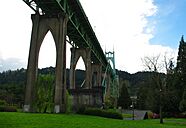 |
|
| Centennial | Southeast | East Portland Community Office | |||
| Collins View | Southwest | Southwest Neighborhoods | 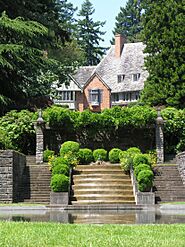 |
||
| Concordia | Northeast | Northeast Coalition of Neighborhoods | Named after Concordia University (now part of University of Oregon Portland). | 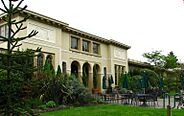 |
|
| Creston-Kenilworth | Southeast | Southeast Uplift Neighborhood Coalition | Creston's name origin is unknown. Kenilworth is from Sir Walter Scott's novel Kenilworth. A Romance. | 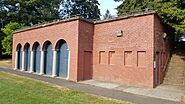 |
|
| Crestwood | Southwest | Southwest Neighborhoods | |||
| Cully | Northeast | Northeast Coalition of Neighborhoods | Named after settler Thomas Cully. | 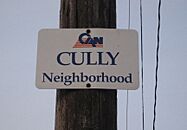 |
|
| Chinatown | Northwest | Neighbors West-Northwest | Named for the many Chinese businesses and homes that were historically here. | 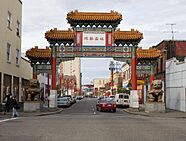 |
This is the Northwest part of Old Town Chinatown. |
| Downtown | Southwest | Neighbors West-Northwest | This is Portland's main city center. | 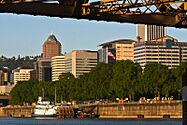 |
|
| East Columbia | North, Northeast | North Portland Neighborhood Services | Named after the Columbia River. | ||
| Eastmoreland | Southeast | Southeast Uplift Neighborhood Coalition | Named after pioneer Julius C. Moreland. | 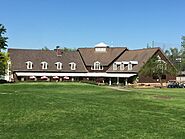 |
|
| Eliot | North, Northeast | Northeast Coalition of Neighborhoods | Named after Rev. Thomas Lamb Eliot. | 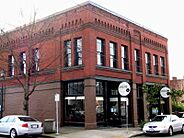 |
This was once the center of Albina, Oregon before it joined Portland. |
| Far Southwest | Southwest | Southwest Neighborhoods | It's the farthest southwest neighborhood in Portland. | 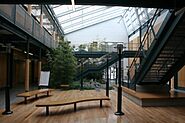 |
|
| Forest Park | Northwest | Neighbors West-Northwest | Named after Forest Park. | 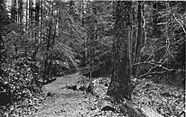 |
|
| Foster-Powell | Southeast | Southeast Uplift Neighborhood Coalition | Named after Foster Road and Powell Boulevard. These roads were named for farmer Philip Foster and settler Jackson Powell. | 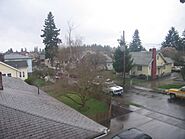 |
|
| Glenfair | Northeast, Southeast | East Portland Community Office | Named after Glenfair Park. | 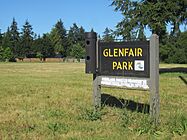 |
|
| Goose Hollow | Southwest | Neighbors West-Northwest | Named for the many wild Geese that used to live in the area. | 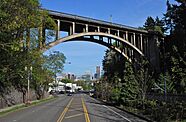 |
|
| Grant Park | Northeast | Central Northeast Neighbors | Named after Grant Park, which was named for President Ulysses S. Grant. | 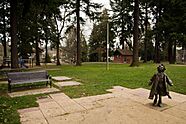 |
|
| Hayden Island | North | North Portland Neighborhood Services | Named after Hayden Island, which was named for settler Gay Hayden. |  |
|
| Hayhurst | Southwest | Southwest Neighborhoods | 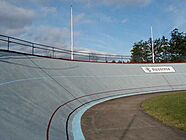 |
||
| Hazelwood | Northeast, Southeast | East Portland Community Office | |||
| Healy Heights | Southwest | Unaffiliated | 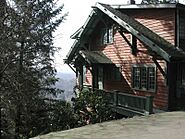 |
||
| Hillsdale | Southwest | Southwest Neighborhoods | Named for the Tualatin Mountains (West Hills). | 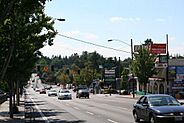 |
|
| Hillside | Northwest | Neighbors West-Northwest | Named for the Tualatin Mountains (West Hills). |  |
|
| Hollywood | Northeast | Central Northeast Neighbors | Named after the Hollywood Theatre. | 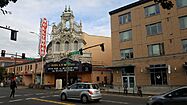 |
|
| Homestead | Southwest | Southwest Neighborhoods | This was the location of the homestead (original farm and home) of State Representative Philip Augustus Marquam. |  |
|
| Hosford-Abernethy | Southeast | Southeast Uplift Neighborhood Coalition | Hosford: Named after Methodist Missionary Chauncey Hosford. Abernethy: Named after Provisional Governor of Oregon George Abernethy. | 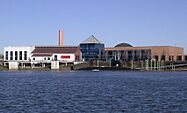 |
|
| Humboldt | North, Northeast | Northeast Coalition of Neighborhoods | |||
| Irvington | Northeast | Northeast Coalition of Neighborhoods | Named after the Irvington Investment Company, which helped create the neighborhood. | 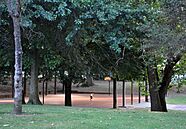 |
|
| Kenton | North | North Portland Neighborhood Services | 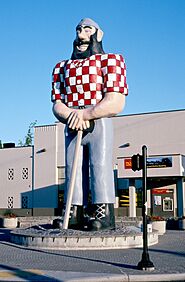 |
||
| Kerns | Northeast, Southeast | Southeast Uplift Neighborhood Coalition | Named after settler William Kerns. | 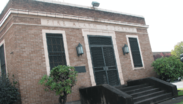 |
|
| King | Northeast | Northeast Coalition of Neighborhoods | Named after Rev. Martin Luther King Jr.. | ||
| Laurelhurst | Northeast, Southeast | Southeast Uplift Neighborhood Coalition | Named after the Laurelhurst Company, which helped develop the neighborhood. | 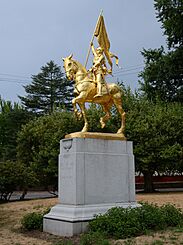 |
|
| Lents | Southeast | East Portland Community Office | Named after settler Oliver P. Lent. | 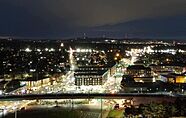 |
|
| Linnton | Northwest | Neighbors West-Northwest | Named after US Senator Lewis F. Linn from Missouri. | 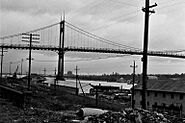 |
|
| Lloyd District | North, Northeast | Northeast Coalition of Neighborhoods | Named after developer Ralph Lloyd, who started Lloyd Center, once a very large shopping mall. | 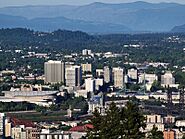 |
|
| Madison South | Northeast | Central Northeast Neighbors | Named after James Madison High School (now Leodis V. McDaniel High School). | 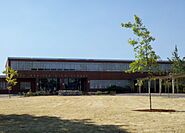 |
|
| Maplewood | Southwest | Southwest Neighborhoods | 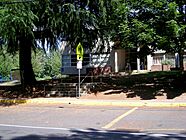 |
||
| Markham | Southwest | Southwest Neighborhoods | |||
| Marshall Park | Southwest | Southwest Neighborhoods | Named after Marshall Park, which was donated to the city by Frederick C. and Addie Mae Marshall. | ||
| Mill Park | Southeast | East Portland Community Office | 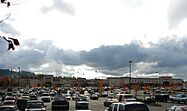 |
||
| Montavilla | Northeast, Southeast | Southeast Uplift Neighborhood Coalition | A mix of "Mount Tabor Village." |  |
|
| Mt. Scott-Arleta | Southeast | Southeast Uplift Neighborhood Coalition | Mt. Scott: Named after Harvey W. Scott, an editor. Arleta: Named after the daughter of one of the neighborhood's first developers. | 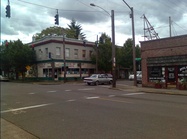 |
|
| Mount Tabor | Southeast | Southeast Uplift Neighborhood Coalition | Named after Mount Tabor, which was named for the biblical Mount Tabor. |  |
|
| Multnomah/Multnomah Village | Southwest | Southwest Neighborhoods | Named after the Multnomah Tribe or Chief Multnomah. | 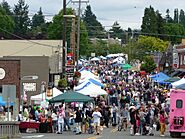 |
|
| North Tabor | Southeast | Southeast Uplift Neighborhood Coalition | Named after Mount Tabor, which was named for the biblical Mount Tabor. | 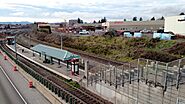 |
|
| Northwest District | Northwest | Neighbors West-Northwest | Located in Northwest Portland. | 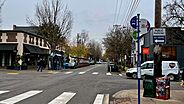 |
Includes areas like Uptown, Nob Hill, Alphabet District, and Slabtown. |
| Northwest Heights | Northwest | Neighbors West-Northwest | Located in Northwest Portland. | ||
| Northwest Industrial | Northwest | Neighbors West-Northwest | Named for the many industrial businesses in the area. |  |
|
| Old Town | Southwest | Neighbors West-Northwest | This is the original and "oldest part of town" in Portland. | 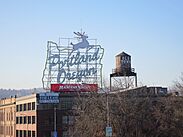 |
This is the Southwest part of Old Town Chinatown. |
| Overlook | North | North Portland Neighborhood Services | The neighborhood is on a bluff that looks out over the city. | 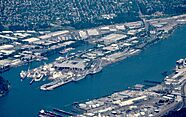 |
Includes Swan Island. |
| Parkrose | Northeast | East Portland Community Office | 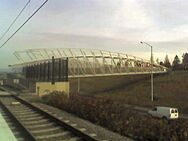 |
||
| Parkrose Heights | Northeast | East Portland Community Office | |||
| Pearl District | Northwest | Neighbors West-Northwest | A local journalist named Terry Hammond came up with the name for reasons that are not fully known. | 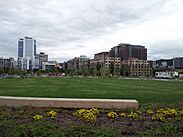 |
|
| Piedmont | North, Northeast | North Portland Neighborhood Services | 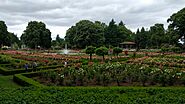 |
||
| Pleasant Valley | Southeast | East Portland Community Office | |||
| Portsmouth | North | North Portland Neighborhood Services | Named after the Port of Portland. | 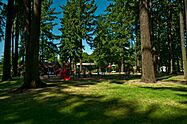 |
|
| Powellhurst-Gilbert | Southeast | East Portland Community Office | Named after two schools in the area: Powellhurst (for settler Jackson Powell) and Gilbert Heights (for settler William M. Gilbert). | 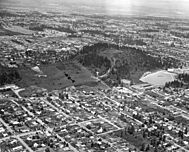 |
Includes the recently formed Jade District. |
| Reed | Southeast | Southeast Uplift Neighborhood Coalition | Named after Reed College, which was named for pioneers Simeon Gannett & Amanda Reed. |  |
|
| Richmond | Southeast | Southeast Uplift Neighborhood Coalition | Named after settler Richmond Kelly, son of Rev. Clinton Kelly. | 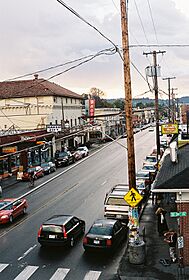 |
|
| Rose City Park | Northeast | Northeast Coalition of Neighborhoods | Refers to Portland's nickname, the City of Roses. |  |
|
| Roseway | Northeast | Central Northeast Neighbors | Refers to Portland's nickname, the City of Roses. | 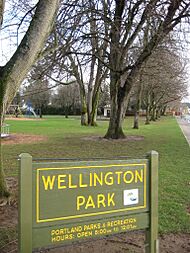 |
|
| Russell | Northeast | East Portland Community Office | 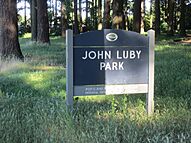 |
||
| Sabin | Northeast | Northeast Coalition of Neighborhoods | 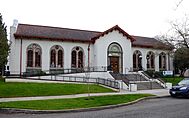 |
||
| St. Johns | North | North Portland Neighborhood Services | Named after settler James John. | 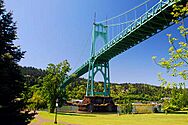 |
|
| Sellwood-Moreland (Westmoreland) | Southeast | Southeast Uplift Neighborhood Coalition | Sellwood: Named after Rev. John Sellwood. Moreland: Named after pioneer Julius C. Moreland. | 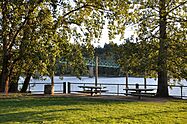 |
|
| South Burlingame | Southwest | Southwest Neighborhoods | 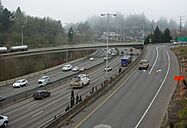 |
||
| South Portland | South | Southwest Neighborhoods | It's located south of Downtown Portland. | 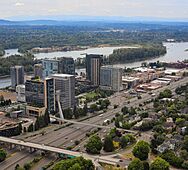 |
Includes South Waterfront, Lair Hill, and Corbett. |
| South Tabor | Southeast | Southeast Uplift Neighborhood Coalition | Named after Mount Tabor, which was named for the biblical Mount Tabor. | 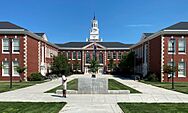 |
|
| Southwest Hills | Southwest | Southwest Neighborhoods | Named for the Tualatin Mountains (West Hills). | 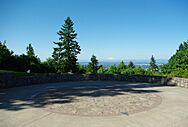 |
Partially in Portland and unincorporated Multnomah County. |
| Sullivan's Gulch | Northeast | Northeast Coalition of Neighborhoods | Named after settler Timothy Sullivan. | 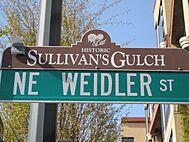 |
|
| Sumner | Northeast | Central Northeast Neighbors | 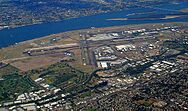 |
||
| Sunderland | Northeast | Central Northeast Neighbors | 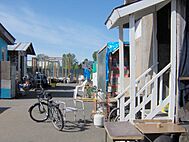 |
Includes Dignity Village. | |
| Sunnyside | Southeast | Southeast Uplift Neighborhood Coalition | 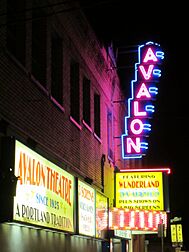 |
||
| Sylvan-Highlands | Southwest | Neighbors West-Northwest | Named after Silvanus, the Roman God of the Woods. | ||
| University Park | North | North Portland Neighborhood Services | Named after Portland Methodist Episcopal University (now University of Portland). | 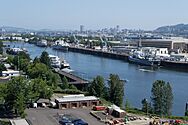 |
|
| Vernon | Northeast | Northeast Coalition of Neighborhoods | 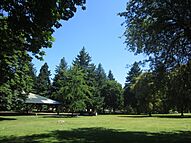 |
||
| West Portland Park | Southwest | Southwest Neighborhoods | It's the western part of Portland. | 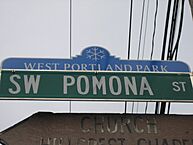 |
|
| Wilkes | Northeast | East Portland Community Office | Named after the Wilkes Family of settlers. | ||
| Woodland Park | Northeast | East Portland Community Office | This is Portland's smallest neighborhood. | ||
| Woodlawn | Northeast | Northeast Coalition of Neighborhoods | 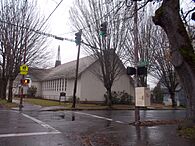 |
||
| Woodstock | Southeast | Southeast Uplift Neighborhood Coalition | Named after Sir Walter Scott's novel Woodstock. |  |
Other Cool Areas and Communities
Beyond the official neighborhoods, Portland has many other interesting spots:
- Alberta Arts District: A lively area with art, shops, and restaurants. It's found within the King, Vernon, and Concordia neighborhoods.
- Albina: This used to be a separate city that became part of Portland in 1891.
- The Belmont Area: A popular place for shopping and homes, located in the Buckman, Sunnyside, and Mt. Tabor neighborhoods.
- Dunthorpe: A fancy area just outside the city limits, north of Lake Oswego.
- East Portland: This was also a separate city that joined Portland in 1891. Don't confuse it with the larger area of Portland generally east of I-205.
- The Hawthorne District: A fun area with shops, restaurants, and cultural spots. It runs through the Buckman, Hosford-Abernethy, Sunnyside, Richmond, and Mt. Tabor neighborhoods.
- Maywood Park: A neighborhood in Northeast Portland that is its own small city, completely surrounded by Portland.
- Peacock Lane: A charming street in the Sunnyside Neighborhood known for its amazing free holiday light displays every December since the 1940s!
- Vanport: This was a city in what is now North Portland. It was sadly destroyed by a big flood in 1948.

